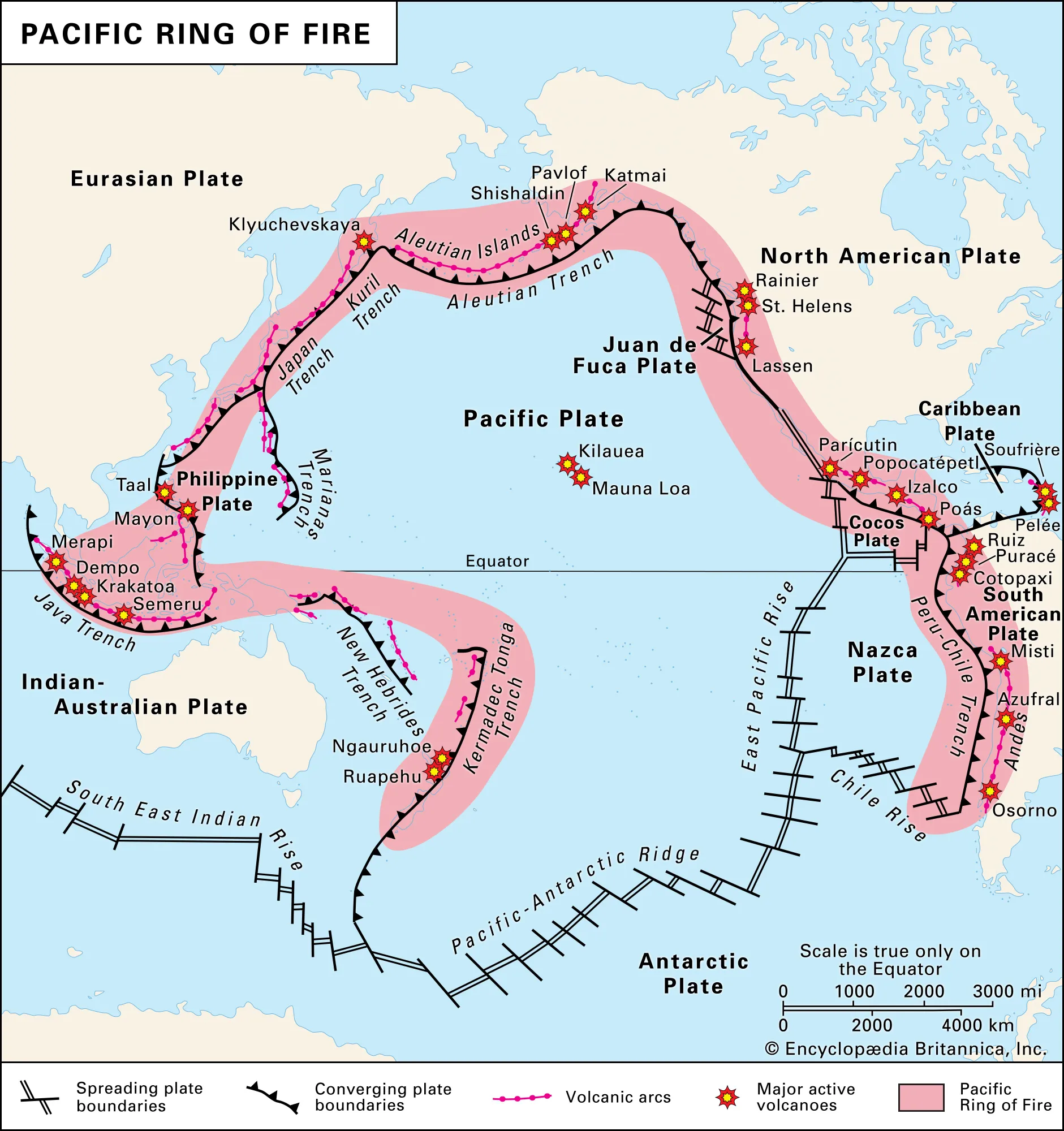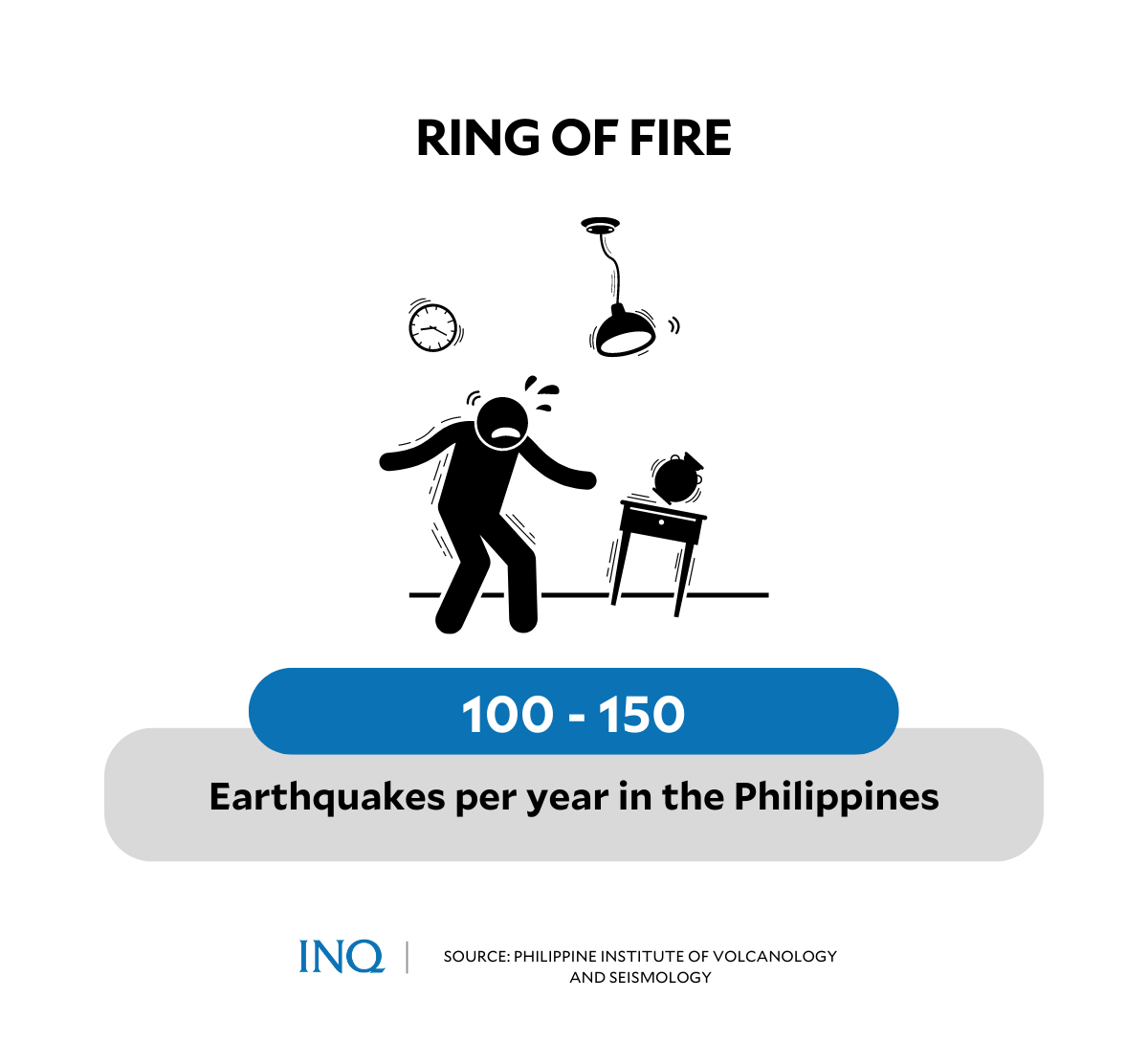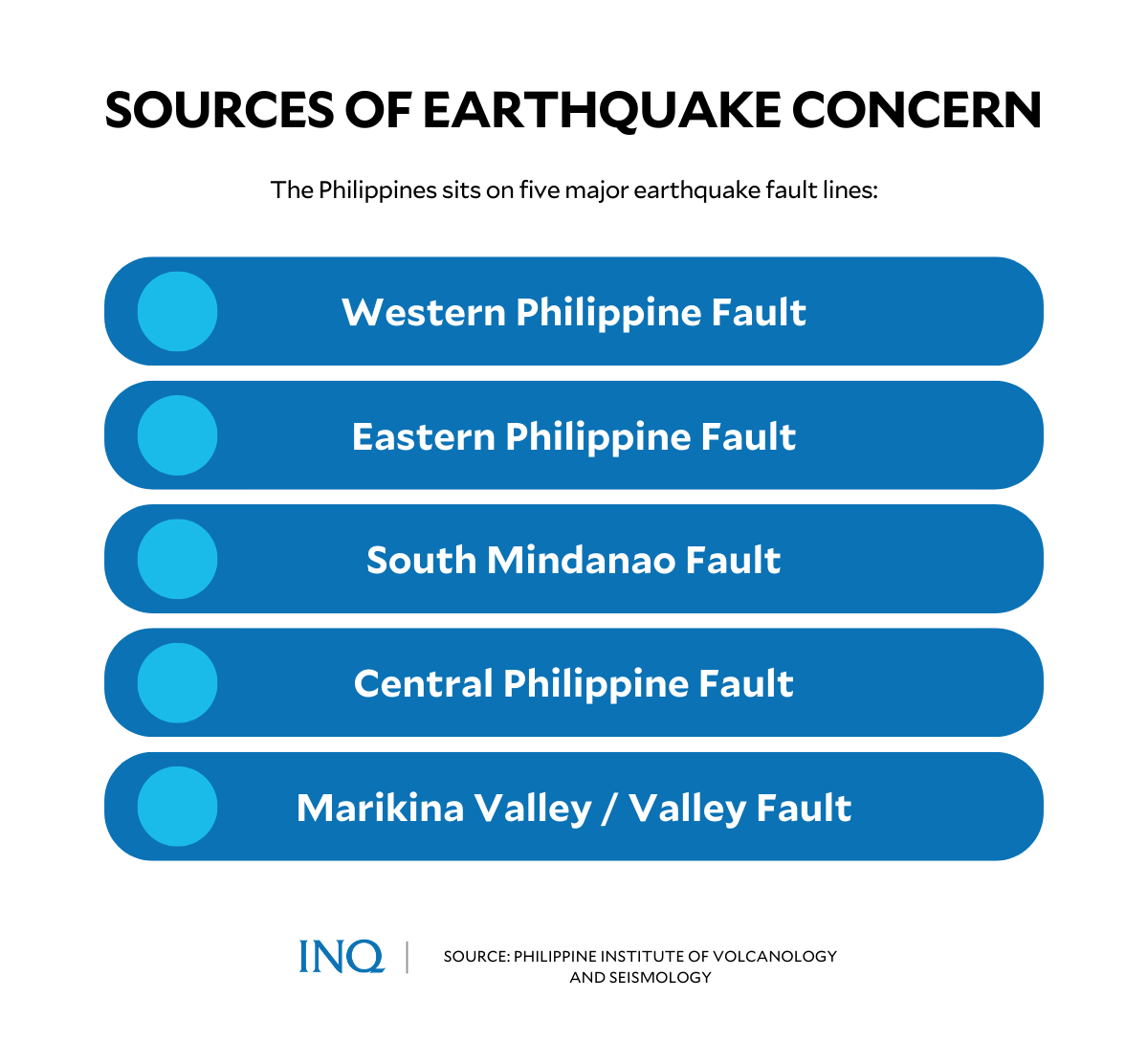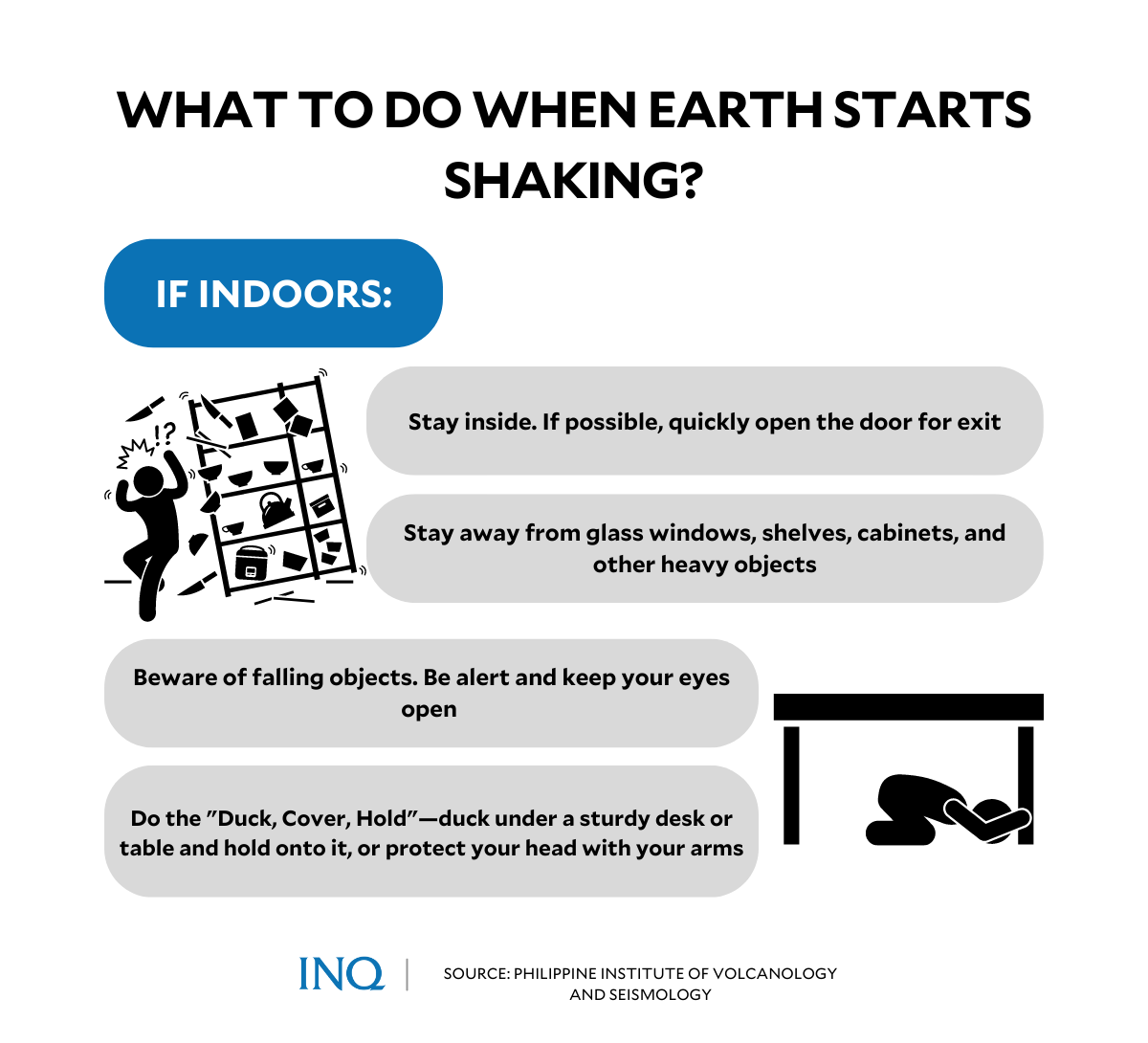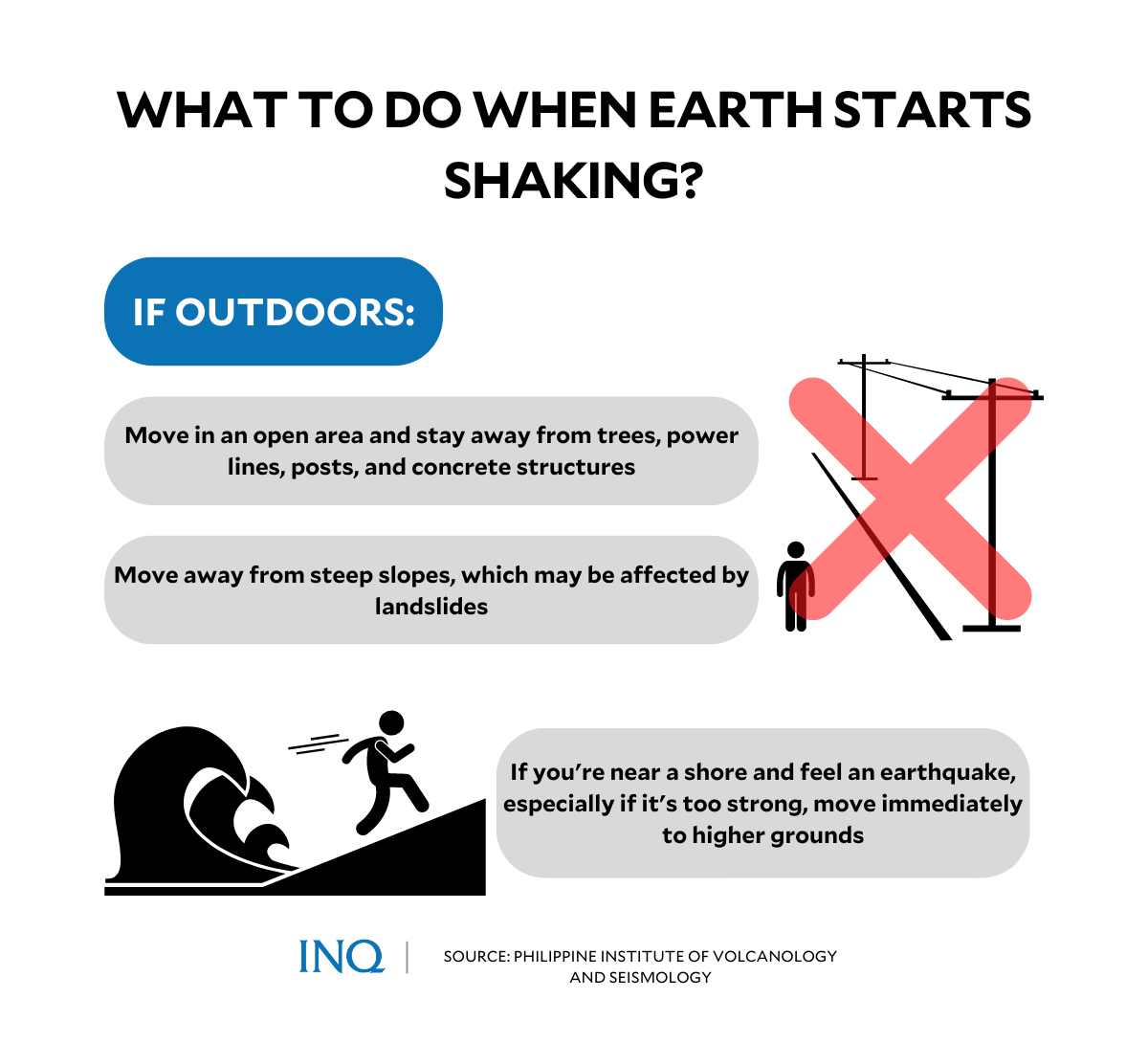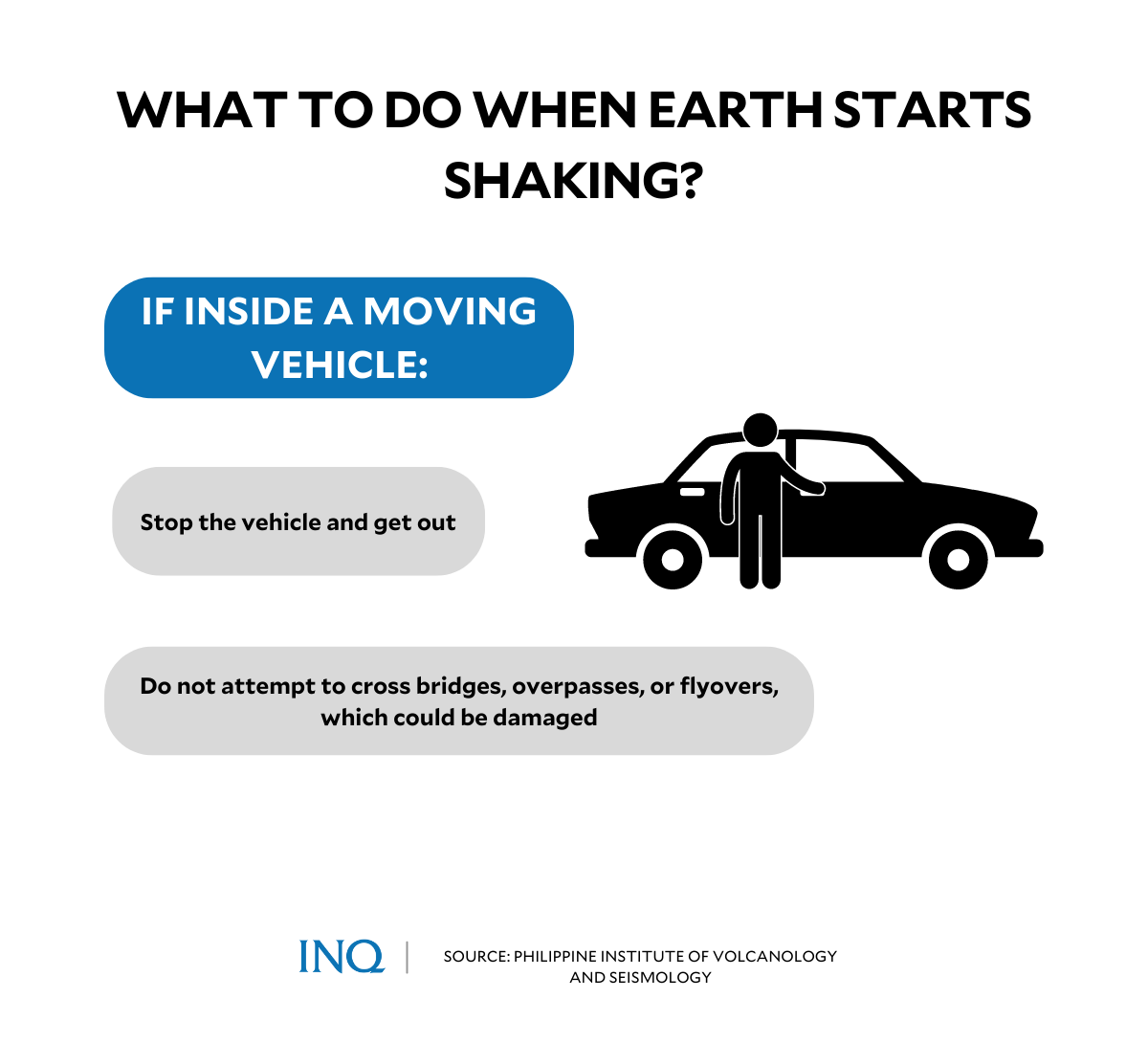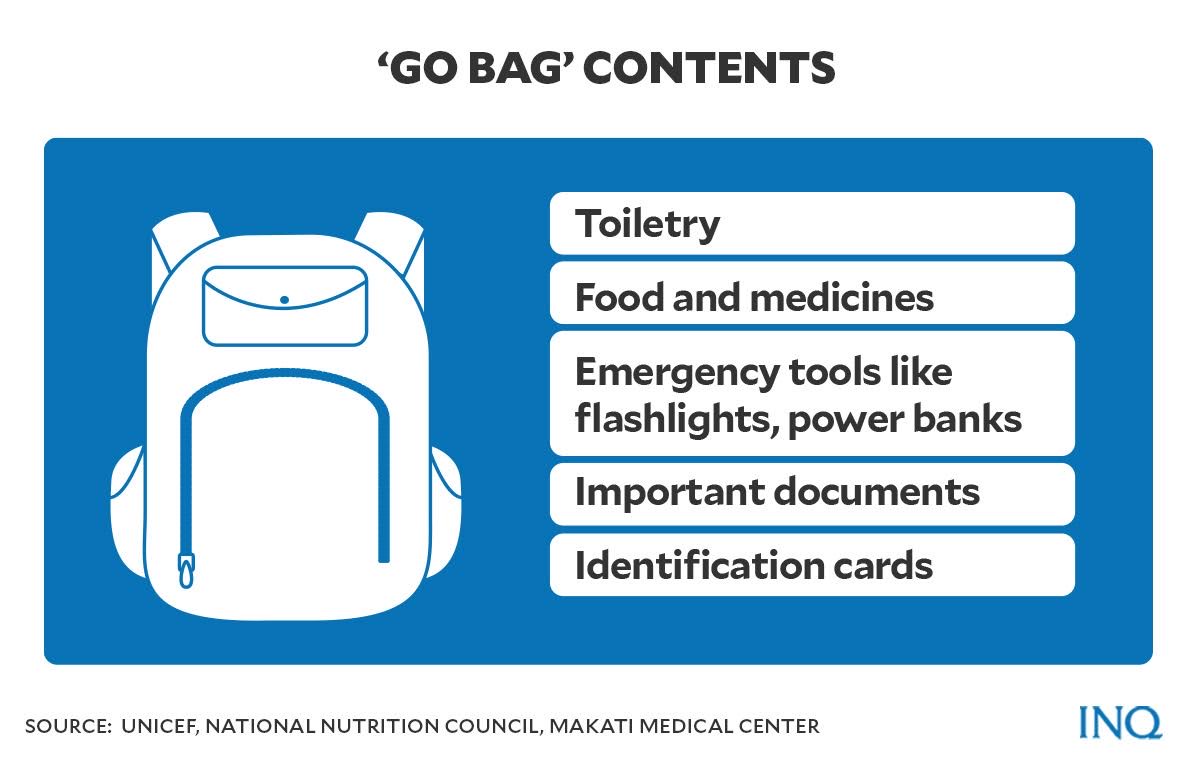Earthquake preparedness saves lives: What to do
MANILA, Philippines—Can earthquake drills actually help save lives and lessen casualties, especially in earthquake-prone countries such as the Philippines?
The Philippines, located at the western edge of the so-called “Pacific Ring of Fire,” is known as one of the most earthquake-prone countries in the world—experiencing at least 100 to 150 earthquakes per year, according to the Philippine Institute of Volcanology and Seismology (Phivolcs).
The country, with a land area of around 300,000 sq km, is home not only to its 110 million population but also to five major earthquake fault lines—the Western Philippine Fault, Eastern Philippine Fault, South of Mindanao Fault, Central Philippine Fault, and the Markina or Valley Fault.
A fault line, according to Oxford Learner’s Dictionary, is “a place where there is a long break in the rock that forms the surface of the earth and where earthquakes are more likely to happen.”
In the past decade, the Philippines has been hit by 10 strong earthquakes, with magnitudes ranging from 6.1 to 7.8. These earthquakes resulted in the death of over 11,000 people, the deadliest of which was the 1976 Moro Gulf earthquake and tsunami that killed 8,000 individuals.
Article continues after this advertisementREAD: LIST: Killer earthquakes in the Philippines
This week, the northern province of Abra was struck by a magnitude 7 earthquake, which resulted in strong tremors felt through Metro Manila and other parts of Luzon. According to the National Disaster Risk Reduction and Management Council (NDRRMC), the earthquake has so far killed at least 5 persons. An NDRRMC update early Friday (July 29) said the death toll has risen to six.
Article continues after this advertisement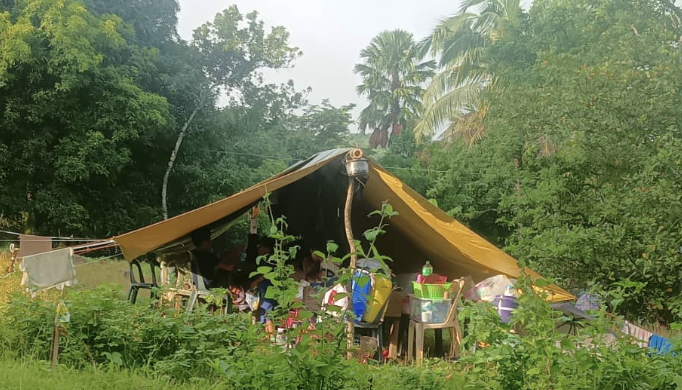
LIVING OUTSIDE. A day after the devastation caused by the earthquake, residents of Barangay Nagtipulan, Lagangilan town, Abra province shelter under a tent for fear of aftershocks. PHOTO COURTESY OF PONY OLMERO
READ: 5 now dead in Abra earthquake, says NDRRMC
To increase the chances of survival in the event of an earthquake, authorities, private companies, and groups conduct earthquake drills annually. But, how effective is it really in saving the lives of people amid an earthquake?
‘Drop, cover, hold’
Each year, the Philippines holds simultaneous earthquake drills to help the public prepare for earthquakes—especially the “Big One,” a scenario in which a magnitude 7.2 earthquake in the Philippine capital Metro Manila is estimated to instantly kill at least 34,000 people, with 24,000 dead or dying in the rubble.
READ: Nov. 12 nationwide quake drill: Duck, cover, hold at home, offices
It is also expected to result in 110,000 people injured and 500 fires raging simultaneously.
READ: Are Filipinos prepared for the Big One?
According to the Philippine Institute of Volcanology and Seismology (Phivolcs), here are the things that the public should do during an earthquake:
If a person is inside a structurally sound building or home:
- Stay inside. If possible, quickly open the door for exit.
- Stay away from glass windows, shelves, cabinets, and other heavy objects.
- Beware of falling objects. Be alert and keep your eyes open.
- Do the “Duck, Cover, Hold”—duck under a sturdy desk or table and hold onto it, or protect your head with your arms.
According to the Earthquake Country Alliance (ECA), rescuers recommend the drop, cover, and hold on procedure since it gives a person “the best overall chance of quickly protecting yourself in an earthquake… even during quakes that cause furniture to move about rooms and in buildings that might ultimately collapse.”
“The main point is to not try to move but to immediately protect yourself as best as possible where you are. Earthquakes occur without any warning and may be so violent that you cannot run or crawl. You, therefore, will most likely be knocked to the ground where you happen to be,” said ECA.
“You will never know if the initial jolt will turn out to be the start of the big one. You should Drop, Cover, and Hold On immediately!”
Moreover, the ECA reminded the public not to get in a doorway and not to run outside.
“As with anything, practice makes perfect. To be ready to protect yourself immediately when the ground begins to shake, practice Drop, Cover, and Hold On as children do in school at least once each year,” it added.
If a person is outside, Phivolcs advised to:
- Move in an open area and stay away from trees, power lines, posts, and concrete structures.
- Move away from steep slopes, which may be hit by landslides.
- If you’re near a shore and feel an earthquake, especially if it’s too strong, move immediately to higher grounds.
For those inside a moving vehicle when an earthquake hits:
- Stop the vehicle and get out.
- Do not attempt to cross bridges, overpasses, or flyovers, which could be damaged.
All of these things, from the proper way to cover your head using your arms to how to properly exit a building or infrastructure after the earthquake, are taught during drills to young children in schools and adults as well.
Other early preparations
According to Phivolcs, aside from remembering what one should do during an earthquake, the public can also plan ahead.
“The key to effective disaster prevention is planning,” said Phivolcs.
Among the ways the public can prepare for an earthquake include:
- Familiarize and remember earthquake hazards in your area.
- Follow structural design and engineering practices when constructing a house or building.
- Regularly evaluate the structural soundness of buildings and houses. Strengthen or retrofit if necessary.
Phivolcs also recommended preparing homes, workplaces, or schools by:
- Strapping or bolting heavy furniture or cabinets to walls.
- Checking the stability of hanging objects like ceiling fans and chandeliers.
- Properly storing breakable items, harmful chemicals, and flammable materials on the lowermost shelves.
Most importantly, Phivolcs reminded the public to:
- Familiarize themselves with exit routes.
- Know where fire extinguishers, first aid kits, alarms, and communication facilities are located. Learn how to use these beforehand.
- Conduct and participate in regular earthquake drills.
- Prepare an emergency “go bag.”
According to Unicef, emergency kits or Go Bags should include:
- Toiletries—anti-bacterial soap, toothbrush, toothpaste, clothes, mosquito repellant, menstrual pads, wet wipes, diapers for babies, and COVID-19 safety kit (face masks, hand sanitizers, or 70% rubbing alcohol).
- Food and medicines—clean drinking water, ready-to-eat food that has a long shelf life, first aid kit (alcohol, band-aids, antiseptics, bandages, tweezer), medicines (for fever, colds, diarrhea, etc.), thermometer and vitamins.
- Emergency tools: flashlight (crank-type or battery operated), fully charged power bank, whistle (for each member of the family), candles and matches, ropes, raincoats, portable radio, blankets, notebook and pen or pencil, list of emergency numbers, and toys or comfort objects for children.
- Important documents: passports, marriage certificates, property and insurance documents, medical records, etc.
- Government-issued IDs or any ID which indicates the person’s blood type and emergency contact information.
- Emergency money, ATM card, passbook.
- Clean clothes.
Earthquake drills save lives
Following the magnitude 7.3 Luzon earthquake on December 12, 1999, the country’s then-defense chief Orlando Mercado said that the government’s disaster preparedness program—including earthquake drills—helped minimize casualties.
In a statement at the time, Mercado said the earthquake drills in public buildings held prior to the strong earthquake have kept various hospitals and other establishments “on their toes.”
He recalled the orderly conduct of doctors, nurses, and patients at the government-run Philippine General Hospital (PGH) in Manila at the height of that Luzon earthquake.
“The patients (at PGH) said that their evacuation was very orderly because they conducted a drill before the earthquake. That’s why we are requiring these drills in all hospitals and public buildings,” he said at the time.
“It is important that we move on from disaster response to disaster preparedness,” he added, emphasizing his call on schools, hospitals, and other public buildings to continue holding fire and earthquake drills.
The same observation was also noted in 2012 when twin earthquakes hit southwest China.
Based on an article published by the Beijing Times, when the earthquakes struck, 1,102 students in the Maoping Central Primary School In Yiliang county in Yunnan province moved from the teaching building to the playground within a minute.
The article said none of the students was injured or killed in the earthquake, “thanks to regular earthquake drills the schools arranged after the Wenchuan earthquake in 2008.”
READ: Poor hard hit by China quakes
In an interview last March, Phivolcs Director Renato Solidum Jr. urged the public to participate in earthquake drills to know what they need to do before, during, and after an earthquake.
“People need to help themselves as help from others will not arrive right away during large-scale earthquakes,” Solidum said.
“Participation in drills is important. This will increase the chance of people surviving a strong earthquake,” he added.
According to the Great Central U.S. ShakeOut, a multi-state drill spanning much of the central United States, taking part in earthquakes drills can help the public practice how they can react quickly and safely during an earthquake.
“You may only have seconds to protect yourself in an earthquake before strong shaking knocks you down—or drops something on you. Practicing helps you be ready to respond,” the organization behind the multi-state drill explained.
Barriers, hindrances
While earthquake drills have been found helpful in saving lives, a study by the Humanitarian Initiative (HHI) in 2018 found that 47.5 percent of respondents said they have not done anything to prepare themselves for a disaster in five years, and only 36 percent said they feel prepared enough.
READ: Why disaster preparedness should be part of your plan
A 2014 paper evaluating the ShakeOut earthquake drill held in a school in New Zealand found that while the majority of 8,000 participants were fully compliant with the directions and instructions, a survey showed that 37.6 percent were reluctant to participate fully in the drill.
When asked why observers or the survey respondents thought people were reluctant to drop, cover, and hold, survey results cited the following reasons:
- disability: 31.8 percent
- age (fragility): 27.2 percent
- restrictive clothing: 3.0 percent
- embarrassment: 43.1 percent
- did not have a place to drop, cover, and hold
“Who wants their colleagues to see that they can’t get under their own desk?” said Sara McBride, the United States Geological Survey social scientist who led the study.
Post-earthquake care
According to studies, earthquake-related casualties occur hours after the earthquake has hit an area. Certain medical conditions, such as complications due to being crushed in rubble or collapsed buildings, are considered indirect causes of earthquake-related death and injury.
READ: Dying in an earthquake: Experts say it’s not just the tremor
According to the United States Geological Survey (USGS), it is crucial to check for injuries after an earthquake. It reminded the public:
- If a person is bleeding, put direct pressure on the wound, use clean gauze or cloth if available
- If a person is not breathing, administer CPR
- Do not attempt to move seriously injured persons unless they are in further danger of injury
- Cover injured persons with blankets to keep warm
- Seek medical help for serious injuries
Aside from what to do before and during an earthquake, Phivolcs also said it is important to check for the following hazards:
- Water and electrical lines for damages.
- Spills, toxic, and flammable materials.
- Fires, which may spread.
“If you need to evacuate your residence, leave a message stating where you are going and bring your emergency supply kit,” said Phivolcs.
“Be prepared for aftershocks. Once the shaking stops, take the fastest and safest way out of the building. Don’t use elevators, enter damaged buildings, use telephones unless necessary,” and most importantly, “don’t panic.”
